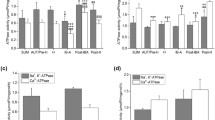Abstract
Skeletal muscle hexokinase (HK) from Richardson’s ground squirrels was analyzed to determine how the enzyme is regulated during hibernation, a state of cold torpor. The HK II isozyme dominated in muscle and ~15% of total HK was bound to the insoluble fraction. HK maximum activity was 33% lower in hibernator muscle and the enzyme showed a significantly higher K m ATP (by 80%) and a lower K i for glucose-6-P (by 40%) than euthermic HK (assayed at 22°C). However, 5°C assay significantly reduced K m glucose of hibernator HK. Stimulation of AMP-dependent protein kinase (AMPK) in hibernator extracts elevated the HK activity and reduced K m ATP, but did not affect euthermic HK. Stimulation of protein phosphatases significantly lowered the HK activity in both situations. AMPK-dependent phosphorylation was confirmed by immunopreciptiation of 32P-labeled HK. DEAE-Sephadex ion exchange chromatography revealed two peaks of HK in hibernator muscle extracts (low and high phosphate forms), whereas only a single peak of phospho-HK was present in euthermic muscle. We conclude that differential control of muscle HK in euthermic versus hibernating states is derived from two main regulatory influences, reversible protein phosphorylation and temperature effects on kinetic properties.








Similar content being viewed by others
References
Wilson JE (2003) Isozymes of mammalian hexokinase: structure, subcellular localization and metabolic function. J Exp Biol 206:2049–2057. doi:10.1242/jeb.00241
González C, Ureta T, Sanchez R, Niemeyer H (1964) Multiple molecular forms of ATP:hexose 6-phosphotransferase from rat liver. Biochem Biophys Res Commun 16:347–352. doi:10.1016/0006-291X(64)90038-5
Katzen HM, Schimke RT (1965) Multiple forms of hexokinase in the rat: tissue distribution, age dependency, and properties. Proc Natl Acad Sci USA 54:1218–1225. doi:10.1073/pnas.54.4.1218
Wilson JE (1997) An introduction to the isoenzymes of mammalian hexokinase types I-III. Biochem Soc Trans 25:103–108
Polakis PG, Wilson JE (1985) An intact hydrophobic N-terminal sequence is critical for binding of rat brain hexokinase to mitochondria. Arch Biochem Biophys 236:328–337. doi:10.1016/0003-9861(85)90633-2
Wang LCH, Lee TF (1996) Torpor and hibernation in mammals: metabolic, physiological and biochemical adaptations. In: Fregley MJ, Blatteis CM (eds) Handbook of physiology: environmental physiology, Sect. 4, vol. 1. Oxford University Press, Oxford, pp 507–532
Geiser F (2004) Metabolic rate and body temperature reduction during hibernation and daily torpor. Annu Rev Physiol 66:239–274. doi:10.1146/annurev.physiol.66.032102.115105
Storey KB (2003) Mammalian hibernation: transcriptional and translational controls. Adv Exp Biol Med 543:21–38
MacDonald JA, Storey KB (1998) cAMP-dependent protein kinase from brown adipose tissue: temperature effects on kinetic properties and enzyme role in hibernating ground squirrels. J Comp Physiol [B] 168:513–525. doi:10.1007/s003600050172
Storey KB, Storey JM (2004) Metabolic rate depression in animals: transcriptional and translational controls. Biol Rev Camb Philos Soc 79:207–233. doi:10.1017/S1464793103006195
Storey KB (1997) Metabolic regulation in mammalian hibernation: enzyme and protein adaptations. Comp Biochem Physiol A 118:1115–1124. doi:10.1016/S0300-9629(97)00238-7
Thatcher BJ, Storey KB (2001) Glutamate dehydrogenase from liver of euthermic and hibernating Richardson’s ground squirrels: evidence for two distinct enzyme forms. Biochem Cell Biol 79:11–19. doi:10.1139/bcb-79-1-11
MacDonald JA, Storey KB (1999) Regulation of ground squirrel Na+K+-ATPase activity by reversible phosphorylation during hibernation. Biochem Biophys Res Commun 254:424–429. doi:10.1006/bbrc.1998.9960
English TE, Storey KB (2000) Enzymes of adenylate metabolism and their role in hibernation of the white-tailed prairie dog, Cynomys leucurus. Arch Biochem Biophys 376:91–100. doi:10.1006/abbi.1999.1686
Abnous K, Storey KB (2007) Regulation of skeletal muscle creatine kinase from a hibernating mammal. Arch Biochem Biophys 467:10–19. doi:10.1016/j.abb.2007.07.025
Ritov VB, Kelley DE (2001) Hexokinase isozyme distribution in human skeletal muscle. Diabetes 50:1253–1262. doi:10.2337/diabetes.50.6.1253
Park C, Marqusee S (2005) Pulse proteolysis: a simple method for quantitative determination of protein stability and ligand binding. Nat Methods 2:207–212. doi:10.1038/nmeth740
Brooks SPJ (1994) A program for analyzing enzyme rate data obtained from a microplate reader. Biotechniques 17:1155–1161
Brooks SPJ (1992) A simple computer program with statistical tests for the analysis of enzyme kinetics. Biotechniques 13:906–911
Wilson JE (1995) Hexokinases. Rev Physiol Biochem Pharmacol 126:65–198
Rose IA, Warms JVB (1967) Mitochondrial hexokinase: release, rebinding, and location. J Biol Chem 242:1635–1645
Pastorino JG, Hoek JB, Shulga N (2005) Activation of glycogen synthase kinase 3ß disrupts the binding of hexokinase II to mitochondria by phosphorylating voltage-dependent anion channels and potentiates chemotherapy-induced cytotoxicity. Cancer Res 65:10545–10554. doi:10.1158/0008-5472.CAN-05-1925
Holmes BF, Kurth-Kraczek EJ, Winder WW (1999) Chronic activation of 5′-AMP-activated protein kinase increases GLUT-4, hexokinase, and glycogen in muscle. J Appl Physiol 87:1990–1995
Stoppani J, Hildebrandt AL, Sakamoto K, Cameron-Smith D, Goodyear LJ, Neufer PD (2002) AMP-activated protein kinase activates transcription of the UCP3 and HKII genes in rat skeletal muscle. Am J Physiol 283:E1239–E1248
Acknowledgments
Thanks to J.M. Storey for editorial commentary on the manuscript. The research was supported by a discovery grant from the Natural Sciences and Engineering Research Council of Canada (OPG 6793) to K.B.S. and the Canada Research Chairs program. KA was supported by a scholarship from Ministry of Health and Medical Education of Iran.
Author information
Authors and Affiliations
Corresponding author
Rights and permissions
About this article
Cite this article
Abnous, K., Storey, K.B. Skeletal muscle hexokinase: regulation in mammalian hibernation. Mol Cell Biochem 319, 41–50 (2008). https://doi.org/10.1007/s11010-008-9875-5
Received:
Accepted:
Published:
Issue Date:
DOI: https://doi.org/10.1007/s11010-008-9875-5




